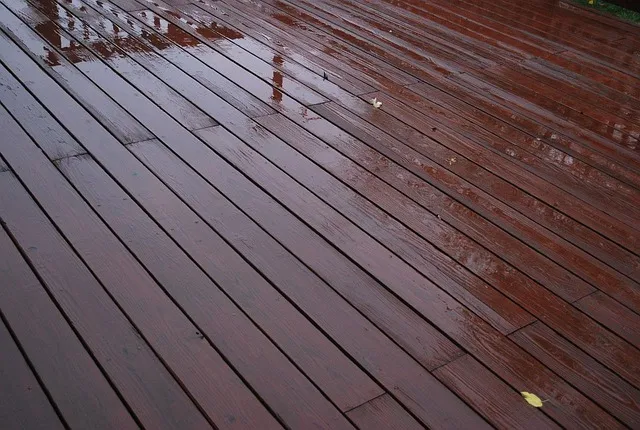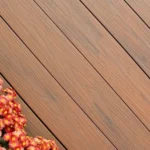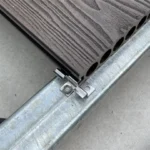Composite decking has become a go-to choice for homeowners looking for a durable, low-maintenance outdoor solution. Among the many color options available, black composite decking offers a sleek, modern look that pairs well with various architectural styles. However, like any outdoor material, it’s not immune to the elements—especially when it comes to black spots caused by mold, mildew, or organic stains.
In this article, we’ll guide you through what causes these spots, how to remove black spots effectively, and how to prevent them from coming back. Whether your deck is black or another dark tone, keeping it clean will help preserve its beauty and extend its life.
What Causes Black Spots on Composite Decking?
Black spots on your composite decking are often caused by:
- Mold and Mildew: Moist environments, especially shady or poorly ventilated areas, are breeding grounds for mold and mildew. These appear as black or dark gray patches.
- Organic Debris: Leaves, dirt, and pollen can settle on your deck. When they decompose, they can leave dark stains.
- Tannin Stains: Stains from wet leaves, bark, or plant matter can leave behind black or brown discoloration.
- Poor Drainage or Water Pooling: If water collects in certain areas, it can lead to moisture buildup, encouraging the growth of mold and mildew.
Are Black Spots Less Noticeable on Black Composite Decking?
You might think that stains are less noticeable on black or dark decking, but that’s not always true. While dark composite decking can hide some dirt and dust, mold and mildew can appear as lighter grayish spots that contrast with the deck’s natural tone. Over time, these stains can dull the appearance of your deck and make it look uneven or dirty.
This is why regular cleaning is still essential—even for black composite decking.
Step-by-Step Guide: How to Remove Black Spots
Follow these simple steps to safely remove black spots from your composite decking:
Step 1: Sweep and Rinse
Start by sweeping the deck to remove loose dirt, leaves, and debris. Rinse the surface with a garden hose to eliminate surface grime.

Step 2: Use a Composite Deck Cleaner or Soap Solution
Apply a store-bought composite decking cleaner according to the instructions, or make a homemade solution with mild dish soap and warm water. Pour it over the black spots or affected areas.
Step 3: Scrub with a Soft-Bristle Brush
Using a soft-bristle brush, scrub the black spots gently in circular motions. Be careful not to use abrasive materials that can scratch the decking surface.
Step 4: Rinse Thoroughly
Rinse the entire deck with clean water. Make sure all cleaner residue and loosened dirt are washed away.
You can get more composite decking cleaning tips from this article: How to Clean Composite Decking: A Step-by-Step Guide.

Optional: Natural Remedies
For tough mold stains, mix white vinegar and baking soda into a paste and apply it to the affected area. Let it sit for 15–20 minutes, scrub gently, and rinse well. Vinegar is a natural mold killer and is safe for most composite materials.
What to Avoid When Cleaning Composite Decking
When cleaning black composite decking, avoid the following:
- Bleach and Harsh Chemicals: These can strip the protective cap layer and cause fading or discoloration.
- High-Powered Pressure Washers: While light pressure washing can be safe, using a pressure washer over 1,500 PSI can damage the surface.
- Wire Brushes or Steel Wool: These abrasive tools can scratch the decking and expose it to moisture and future stains.

Preventing Future Black Spots on Composite Decking
Prevention is the key to keeping your deck looking new. Here’s how you can reduce the risk of black spots:
- Regular Cleaning: Sweep your deck weekly and rinse it occasionally to prevent buildup of organic material.
- Clear Debris Quickly: Remove fallen leaves and dirt promptly, especially after storms.
- Improve Airflow: Trim surrounding plants or bushes to allow more sunlight and air to reach the deck.
- Ensure Proper Drainage: Make sure your deck has a slight slope or drainage system to prevent water pooling.
- Consider Mold-Resistant Treatments: Some composite-friendly sprays or sealants can offer extra protection in humid or shaded areas.
When to Call a Professional
If your deck has deep, widespread staining that doesn’t come off with regular cleaning, it might be time to consult a professional. Additionally, if your composite decking is still under warranty, check with the manufacturer before using unfamiliar cleaners or tools.
Conclusion
Black composite decking offers style and sophistication, but it still needs proper care to stay looking its best. With the right cleaning methods and a little maintenance, you can easily remove black spots and keep your outdoor space clean, safe, and inviting. Prevention is just as important as treatment, so make regular cleaning part of your outdoor routine. If you want to know more about composite decking, you can also read this full guide: Everything You Need to Know About Composite Decking
Looking to make the most of your composite decking and eco-friendly home upgrades? Head over to ecobuildhome.com for expert tips on installation, care, and choosing the best sustainable materials for your space.


